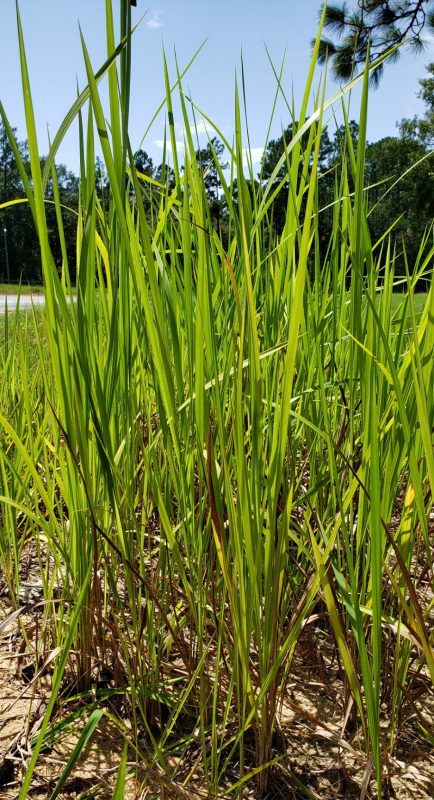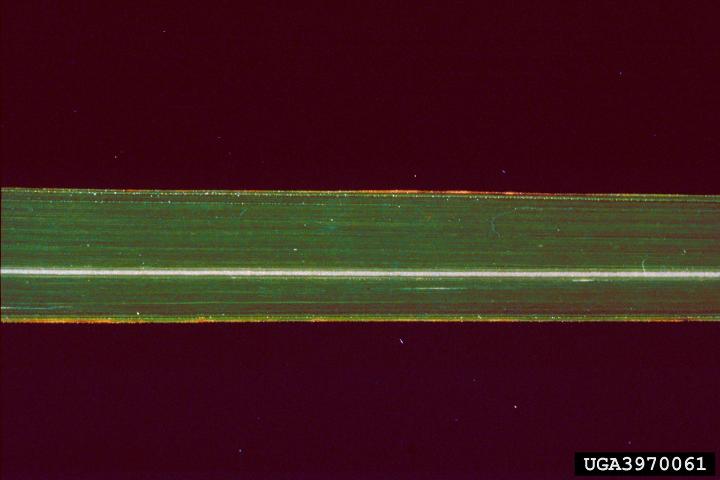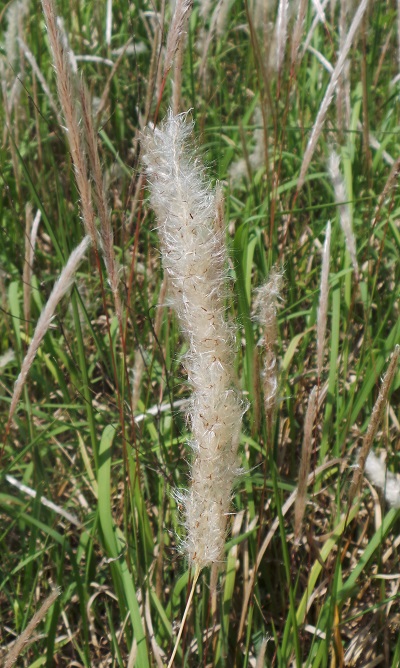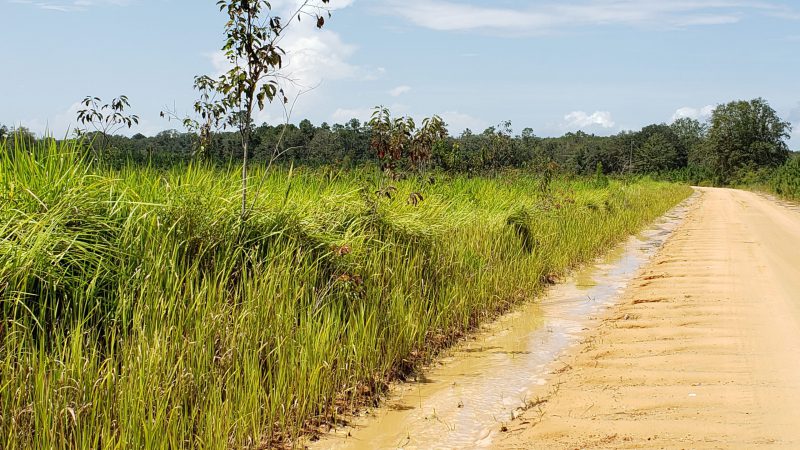Cogongrass is by no means a new issue in Northwest Florida, this highly aggressive, invasive species has been causing problems in pastures, pine plantations, rights-of way, and about everywhere else you can think of for many years. Just because cogongrass is not new doesn’t mean we can forget about it. Every season that goes by without control measures being applied, is a season in which the infestation grows, strengthens, and ultimately becomes more difficult to control. Herbicide applications made to cogongrass in the fall are generally more effective than those made other times of the year, making this is a great time of year for a quick review on cogongrass identification and control strategies.
–
Identification
Cogongrass has many distinguishing features that can be used for identification. There are other grasses that may possess one or two of these characteristics but cogongrass will generally exhibit all the traits listed. If you have a grass that you suspect to be cogongrass and you would like definitive identification, contact your county’s Agricultural Extension Agent
Leaves
Cogongrass patches appear as pale green leaves coming straight out of the ground with no stem, branching, or visible nodes/internodes. The leaves are 2-6 feet in length and taper to a point (Figure 1). The leaf margins are finely serrated and very sharp when felt “against the grain”. The leaves also have a prominent, off-set white midrib (Figure 2).

Figure 1. Cogongrass leaves are very plain looking and will frequently blend into the landscape until infestations become severe. Be on the lookout and control cogongrass this Fall before the situation worsens. Photo Credit: Mark Mauldin

Figure 2. The typical offset, white midrib of a cogongrass leaf. Photo Credit: https://www.forestryimages.org/
–
Seedhead
Cogongrass seedheads are primarily visible during the spring. The seedheads are cottony white and quite airy/fluffy. Seedheads will vary from 2 to 8 inches in length (Figure 3).

Figure 3. Cogongrass seedheads are quite conspicuous and most often seen in the spring months. Photo Credit: Mark Mauldin
Rhizomes
Cogongrass has a very substantial rhizome root system. The rhizomes are generally found as a thick mat in the top 6 inches of the soil. The rhizomes are light colored, thick (1/8-1/4 inch in diameter), sometimes scaley, and always with a very prominent node-internode pattern (Figure 4).

Figure 4. Extensive rhizome growth on a young cogongrass plant. Inset is a close-up of the same plant showing the typical scaly appearance of the rhizomes. Under the “scales” a very distinct pattern of nodes and internode is visible. Photo Credit: Mark Mauldin
–
Control
Control strategies for cogongrass vary considerably by location/situation. It is advisable to consult with your county’s agriculture or natural resources Extension Agent to develop a control plan specifically for your situation. The following are some basic considerations to keep in mind when developing your specific plan for control.
Mechanical/Cultural Control
- Mowing is not an effective method of controlling cogongrass and frequently makes the situation worse.
- Cogongrass is quite tolerant of fire and burns extremely hot greatly endangering any desirable species in the area. Fire is not an effective method for controlling cogongrass but may be part of an integrated approach. Fire removes older, dead leaves and stimulates the growth of new leaves, facilitating the uptake of herbicides.
- Tillage can be a part of a control strategy for cogongrass. Breaking the rhizomes helps to dry them out and deplete stored energy. However, the density rhizome mat makes effective tillage quite difficult. Large, heavy equipment is necessary to break the rhizome mat. Additionally, since cogongrass spreads easily via fragmented rhizomes it is of the utmost importance that all tillage equipment be thoroughly cleaned on-site to prevent further spread (Figure 5).
- In some scenarios it may be feasible and beneficial to plant a cool-season annual (like ryegrass) over dormant cogongrass (assuming foliage has been removed by fire or some other means). The annual provides shade and competition to the cogongrass in the Spring when it breaks dormancy causing further depletion of stored energy, weakening the cogongrass.

Figure 5. Cogongrass spreads very effectively via fragmented rhizomes. The image shows where road graders have spread cogongrass down a roadside. The graders inadvertently break rhizomes as they go along and the fragments are “planted” in the re-deposited soil. Photo Credit: Mark Mauldin
Chemical Control
Cogongrass is VERY difficult to control. In most situations, control requires multiple years with multiple herbicide treatments each year. Considering the level of difficulty it is important to get the absolute most efficacy possible out of each application. Optimizing the timing of applications is a key first step. Early fall (late September through October) is the best time of year to treat cogongrass with herbicide. Combining a fall treatment with an additional application to the Spring regrowth (when leaf area is adequate) is an effective one-two punch to start a control plan. Below are some additional points to consider regarding chemical control of cogongrass.
- There are no selective herbicide options for controlling cogongrass. Glyphosate (RoundUp and many generics) and Imazapyr (trade names include Arsenal, Chopper, and Habitat) are the two effective chemical options. Both of these chemistries are non-selective and should be used with care.
- Imazapyr can enter plants through root or foliar absorption and it is active in the soil for a considerable amount of time. Imazapyr is highly active on hardwood trees and should not be used in areas where roots of desirable trees may be present. Imazapyr is not active on most pine species and is frequently used control cogongrass and other undesirable species in pine plantations.
- Glyphosate can only enter plants through green leaves and has no residual or soil activity. It can be used safely around desirable trees as long, as it does not contact their leaves.
- Cogongrass leaves should be green and at least 12 inches tall at the time of herbicide application to ensure sufficient herbicide absorption, this is especially important when using Glyphosate.
- Adequate spray coverage is crucial maximizing control. Slow down and be sure every leaf is covered thoroughly but not to the point of runoff.
- Don’t forget to include a surfactant with your herbicide. Include an 80/20 NIS (Non-ionic surfactant) at 0.25% to 0.5% v/v (10-20 mL of NIS per gallon of spray solution).
- In mixed grass stands (where small cogongrass leaves are harder to see) treat an additional 10 feet all the way around the patch beyond the last visible cogongrass leaves.
–
More details, including recommended herbicide rates can be found in Cogongrass Biology, Ecology, and Management in Florida Grazing Lands.
- Peanut Maturity Update – 10/9/25 - October 10, 2025
- Fall Can be a Great Time for Vegetation Management - October 3, 2025
- Peanut Maturity Update – 9/25/25 Edition - September 26, 2025
